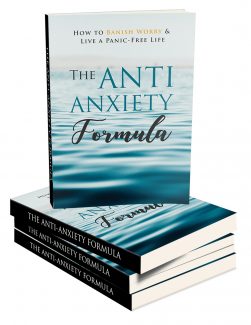 License Type: Master Resell Rights
License Type: Master Resell Rights  File Type: ZIP
File Type: ZIP
 SKU: 62988
SKU: 62988  Shipping: Online Download
Shipping: Online Download
Sample Content Preview
Anything less than perfection feels like failure.
If they do, then there’s a chance that you’re experiencing some degree of anxiety and/or depression. Unpleasant feelings are a part of our daily lives. They are there to teach us a lesson. Once we’ve learned our lesson, they often move on, but might come back with another lesson later.
As a result of these experiences, you’re likely to feel sad and stressed. These are perfectly normal emotions to go through from time to time. Everyone feels low and apprehensive about something or the other at some point in their lives. But when these unpleasant emotions begin to consume you, then you must act before it’s too late.
Fortunately, these feelings can be healed. They can be made to shift to a more positive and constructive space. And we are here to help. The Anti-Anxiety Formula book has been written with especially this in mind.
You will find a wide range of skills and tools to help manage and overcome your anxiety. This book is filled with questions that help you reflect and find answers for yourself. We urge you to give every practice a try before deciding on the ones that work best for you.
On that note, we welcome you to our book titled, ‘The Anti-Anxiety Formula.’ We’ve had an enriching time creating this book and hope that experience translates to our readers too.
Chapter 1 - You and Your Anxiety: How to Overcome Your Stuck Points
Anxiety can creep up on you in many ways from physical and behavioral symptoms that are obvious to subtler symptoms that mess with your emotional and cognitive state of being. Yet, each time, it can leave behind a somewhat similar and familiar feeling - the feeling of being a little more lost, battered, and alone.
No anxious person has the same set of symptoms, which is why each person’s anxiety is unique and therefore their individual journey. That said, most people have some of each type of the symptoms, only in different combinations, which makes understanding how it works more appreciable. This chapter focuses on personality concepts that will help you understand how your anxiety works.
The Multifaceted You
Now, you cannot understand the average anxious person to understand your anxiety. You don’t need to either. You need to understand the many dimensions within which you and your anxiety exist. Once you start identifying these dimensions which are mostly characterized by triggers and symptoms, you’ll be able to work around them, and in time, overcome them too.
Worksheet 1 - What Do You See?
Here’s a quick worksheet for you. Do any of these situations sound familiar to you?
- You dislike change. Every time you are put into a new situation, you feel restless and worried.
- You over process information, decisions, and possibilities before acting.
- You tend to be pessimistic about the present and future.
- You constantly dwell into negative past experiences.
- You worry about everything.
- You feel awkward when someone compliments you. You also believe they don’t mean their compliments or are mocking you in some way.
- You are your harshest critic.
While there is no scoring system here to rate your anxiety, it does help you to understand if you are anxiety-prone or not. The more items you check, the more likely you are suffering from anxiety, depression or both.
Understanding Your Anxiety and What It Is Doing to You
Anxiety on the inside can affect what you do and how you act on the outside. And so, if you were to observe your mind and body carefully, you might be able to notice some signs, behavioral and physical, that can tell you what your anxiety might be doing to you. For instance, an anxious person might be dealing with several conflicting and apprehensive thoughts. The internal noise and fear that reverberates inside might make them appear tired, withdrawn, and/or nervous.
Worksheet 2 - What Does Your Behavior Say of You?
Check off statements that apply to you.
- I find myself crying for no reason.
- There are times when I feel empty and can’t make myself do what I want to do.
- I avoid socializing.
- I avoid risks.
- I also avoid doing fun stuff because I worry about the possible risk involved.
- I’m afraid of failure and judgment.
- I get fidgety.
- I obsess over the past, worry about the future, and can rarely stay in the present.
And About Your Body?
- I have no appetite.
- I’m always hungry.
- My palms sweat all the time.
- I can feel nauseous, lightheaded, cold, and shaky when anxious.
- My heart races when I worry.
- I feel cold and weak too.
- I have very little energy.
Again, there is no scoring system to rate your anxiety. The more symptoms you check off, the more likely you are experiencing anxiety.
Note: Now, some of the above symptoms can also result from various other reasons, and so, we suggest you consult your primary care physician before making any conclusions.
Reflecting upon Your Triggers and Identifying Beliefs That are Standing in Your Way
If you could follow an anxious mind, you might see patterns of unfavorable thoughts that keep playing on and off. These thoughts might be triggers to the anxiety itself, and so addressing them is very important. A clinical technique called imagery exposure, used in therapy, can help address the triggers as well as identify their sources.








